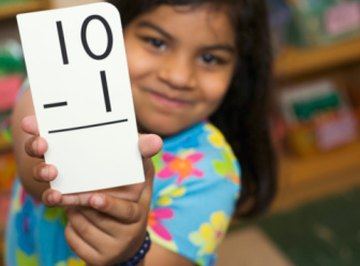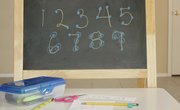
TouchMath is a hands-on, educational program that specifically taps into the sense of touch. It is an ideal tool for early learners to understand math skills before memorizing math facts. It is also a beneficial program for those with learning disabilities who constantly struggle with math operations. When teaching subtraction using TouchMath, students should first be able to count backwards comfortably. It is important, once students grasp how to subtract using the tool, that they not become too reliant on the tactile aids. They must eventually be able to memorize subtraction facts.
Teach students the basics of the TouchMath (touchmath.com) number system. Each number manipulative has three-dimensional dots, called "TouchPoints," arranged on top that prompt children to count foreward or backward. The number 1 has a single point and the number 5 has five points. The number 6 has three TouchPoints consisting of each dot surrounded by a ring, meaning each point needs to be counted twice. The number 9 has four ringed points and one single point. The "Touching/Counting Patterns" section on the "How it Works" page of the TouchMath website demonstrates the TouchPoints for each numeral.
Practice counting backward with your students until they are able to do so without hesitation. Start with counting from 5 to 1 and then increase the range from 10 to 1. Use worksheets, such as tracing numbers in descending order, or count backward with your class while singing the numbers to a tune of a well-known song.
Set up an example subtraction problem using the TouchMath program. The subtrahend (the number being subtracted from the minuend) should have TouchPoints. If you do not have TouchMath manipulatives, you can easily add your own homemade "touch points." For example, if you set up the equation, 7-3, the "7" does not need touch points and the "3" should have touch points.
Show the students how to complete the subtraction problem using the TouchMath method and complete it together. Say the minuend (the number being subtracted from) out loud. Count backward, starting with the following number; each number you count backward corresponds to a point touch on the subtrahend. For example, if you are subtracting 7-3, say "7" out loud; count backwards to correspond to the touch points on the subtrahend, thus saying "6-5-4." The last number said out loud is the answer.
Help students complete further subtraction problems using the TouchMath method until they can complete them independently.
Practice subtraction facts with your students on a regular basis until they are able to recall them quickly without working them out on paper. Use flashcards and games to encourage students to memorize these facts.
References
About the Author
Michelle Brunet has published articles in newspapers and magazines such as "The Coast," "Our Children," "Arts East," "Halifax Magazine" and "Atlantic Books Today." She earned a Bachelor of Science in environmental studies from Saint Mary's University and a Bachelor of Education from Lakehead University.
Photo Credits
Creatas/Creatas/Getty Images
